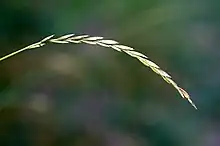Reconstruction:Proto-Slavic/pyrъ
Proto-Slavic
Etymology

Formally from Proto-Balto-Slavic *pū́ˀras m, *pū́ˀra n (descendants flucturate between mobile /in Lithuanian/ and fixed /in Slavic/ accent paradigms), ultimately from Proto-Indo-European *puHrós (“sort of wild wheat”)[1] (according to Witczak, originally Triticum compactum). Cognate with Lithuanian pū̃ras (“corn of winter-wheat”) (plural pūraĩ refers to the plant), Latvian pûr̨i pl (“winter wheat”), Old Prussian pure f (“rye brome”), Ancient Greek πῡρός (pūrós, “wheat”).
Synchronically, represents an o-stem variant of i-stems *pyrь, *pyrьjь, with no discernable difference in meaning. Possibly diachronically formed as a (common) objective counterpart to an earlier (neuter) r/n-stem mass noun. Similar constructions are also found in Proto-Indo-European *wesh₂erós (“spring corn”), *sweh₂réh₂ (“millet”) (whence Lithuanian sóra (“common millet”), Western-Curonian dial. Latvian sūra (“a kind of panicgrass”)).
(The similarity to Chuvash пӑри (pări, “farro or spelt”), occassionally noted in the literature, is however a coincidence as it derives from Proto-Turkic *bodaɣay (“wheat etc.”).)
Alternative forms
- *pỳro n[3], *pỳra f (relic collective)
Declension
| Singular | Dual | Plural | |
|---|---|---|---|
| Nominative | *pyrъ | *pỳra | *pỳri |
| Accusative | *pyrъ | *pỳra | *pỳry |
| Genitive | *pỳra | *pỳru | *pỳrъ |
| Locative | *pỳrě | *pỳru | *pỳrě̄xъ |
| Dative | *pỳru | *pỳroma | *pỳromъ |
| Instrumental | *pỳrъmь, *pỳromь* | *pỳroma | *pỳrȳ |
| Vocative | *pỳre | *pỳra | *pỳri |
Derived terms
- *pyriti (sę) (“to flourish in spelt/couch grass (for field, area)”)
- *pyrika, *pyrina, *pyrovina (“stem, root, or plant material of wheatgrass plant”)
- *pyrьnъ (“partaining to wheatgrass”)
- *pyrьnikъ m, *pyrьnica f (“couch grass”) (in languages where the primary term refers to “spelt”)
Descendants
From masc. o-stem, typically referring to “couch grass”:
- South Slavic:
- West Slavic:
From neut. o-stem, typically referring to “spelt”:
- East Slavic:
- Old East Slavic: пꙑро (pyro)
- Russian: пыро (pyro) (obsolete)
- Ukrainian: пиро (pyro) (obsolete)
- Old East Slavic: пꙑро (pyro)
- South Slavic:
Further reading
- Vasmer, Max (1964–1973), “пыро”, in Этимологический словарь русского языка [Etymological Dictionary of the Russian Language] (in Russian), transl. and suppl. by Oleg Trubachyov, Moscow: Progress
- Duridanov I., Račeva M., Todorov T., editor (1996), “пир²”, in Български етимологичен речник [Bulgarian Etymological Dictionary] (in Bulgarian), volume 5, Sofia: Bulgarian Academy of Sciences, page 250
- Трубачёв, Олег Николаевич (a. 2002) Труды по этимологии: Слово · История · Культура (in Russian), volume I, Moscow: Языки славянской культуры, published 2004, →ISBN, page 772
- Furlan, Metka (2016) Prispevki k slovenski in slovanski etimologiji (Linguistica et philologica), volume 32, Ljubljana: Založba ZRC SAZU, →ISBN, page 123-124
- “pūrai”, in Lietuvių kalbos etimologinio žodyno duomenų bazė [Lithuanian etymological dictionary database], 2007–2012
- Nieminen, Eino (1956), “Die Benennungen der Hirse in den baltischen Sprachen”, in Zeitschrift für vergleichende Sprachforschung auf dem Gebiete der Indogermanischen Sprachen (in German), volume 74. 3./4., pages 162–176
References
- Witczak, Krzysztof (2003) Indoewropejskie nazwy zbóż, Wydawnictwo Uniwersytetu Łódzkiego, pages 91-106
- Olander, Thomas (2001), “pyrъ pyra”, in Common Slavic accentological word list, Copenhagen: Editiones Olander: “a (NA 138, 143; SA 18)”
- Snoj, Marko (2016), “pira”, in Slovenski etimološki slovar3 (in Slovene), https://fran.si: “Pslovan. *py̋ro”